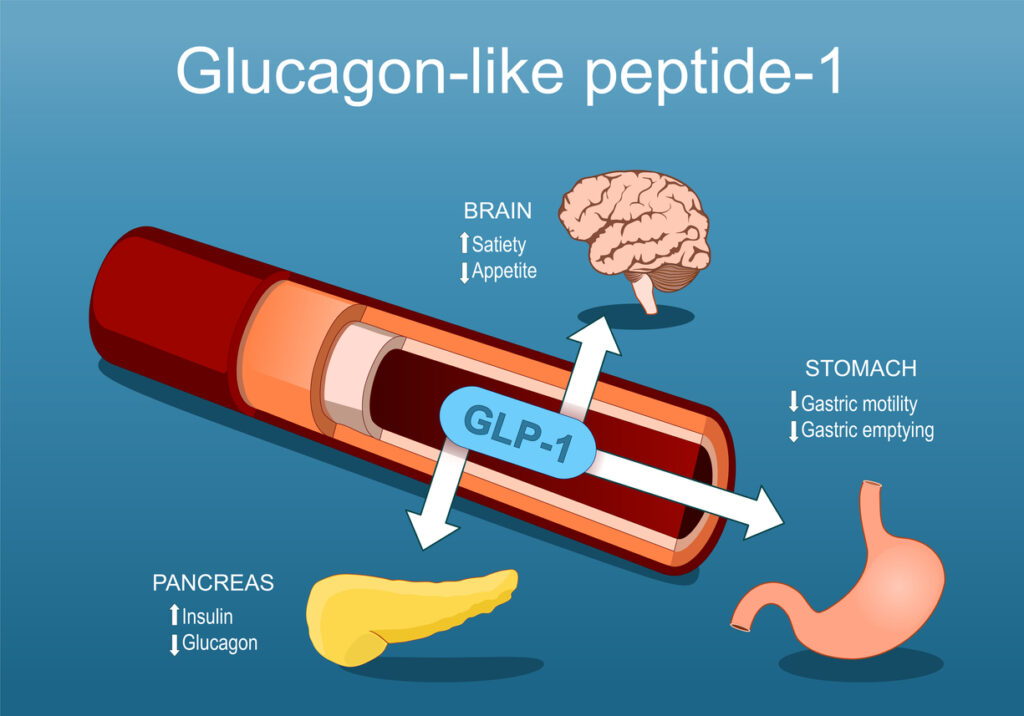
Glucagon-like peptide-1. GLP-1 from blood vessel to pancreas, brain and stomach. relationship between Satiety, Appetite hormones, Insulin, Glucagon, Gastric motility and emptying. Vector Isometric Flat illustration.
With the popularity of GLP-1 agonists on the rise, medications like Ozempic or Wegovy are becoming more and more common in people trying to lose weight. Not only are they becoming more common, but they are becoming more accessible with their recent rise in popularity. There are a few things that are important to note. I’m not a doctor, nor can I say who should or should not be on a GLP-1 medication. With their increasing use, it is important to understand what a GLP-1 agonist is and does while also understanding that being on a GLP-1 agonist drives up the necessity of some things relative to one’s health. Especially in an active or aspiring active person.
First things first.
What is GLP-1?
GLP-1 is a hormone produced by your small intestine. This hormone does a few things:
- It triggers insulin release from your pancreas, which in turn helps to better regulate your blood sugar. Poor blood sugar regulation and insulin sensitivity can lead to high blood sugar and type II diabetes.
- It blocks the secretion of glucagon, which also helps to regulate your blood sugar levels when necessary by preventing more glucose from entering your bloodstream.
- It slows stomach emptying. Slower digestion means a slower release of glucose into the blood and a longer-lasting “full” sensation from the food you eat.
- Increasing mental satiety, or how full you are. It affects the area of the brain that processes hunger and fullness.
See more here: Cleveland Clinic: GLP-1 Agonists
The medications being prescribed, like Ozempic and Wegovy, are called GLP-1 agonists. They mimic the hormone GLP-1 mentioned above. They’re officially on the market as diabetes medications. These medications are prescribed and delivered via injection, and they’re becoming a very common theme amongst people trying to lose weight.
As of right now, GLPs are here to stay. So, let’s dive into how the effects of a GLP-1 agonist on the body can influence one’s health.
A GLP will make one less hungry, which means they’ll eat less, and if they’re eating in a caloric deficit– lose weight. This is great for people trying to lose weight, but eating in deficit without controlling for a few different variables can produce adverse health effects as well.
When we eat in a caloric deficit, our body turns inward to make up the energy balance. It consumes some of the energy-dense mass we store in our bodies. Fat and muscle. Eating less and doing nothing else will cause fat loss, but if done improperly, it can also cause muscle mass loss. Overall, less muscle is bad. Muscle is some of your most metabolically active tissue. It keeps your body strong and mobile. Muscle is also your best blood sugar regulator. It is the main storage point of carbohydrates in your body, storing your carbs in the form of glycogen. Protecting your muscle mass is important. Long term loss of muscle mass has been associated with osteoporosis and other health issues.
Here are a few things that you need to be doing while trying to lose weight, whether assisted by a GLP or not:
- Consume a high-protein diet. NASM, along with other professional organizations, recommends at least 1.6 to 2.2 grams of protein per kilogram of body weight (or 0.73 to 1 gram per pound) for people eating in a deficit. Not eating enough protein while existing in a caloric deficit may cause your body to consume your muscle mass for energy. This is due to the fact that your body starts to burn some protein for fuel while in a caloric deficit. Having enough extra dietary protein allows your body to burn some of your protein for energy without consuming your lean mass.
- Lift weights at least 2-3 times per week. Lifting weights will send your body the other signals it needs to maintain your muscle mass, if not increase it.
- Hire a professional. Someone like a fitness professional, working in conjunction with your doctor, will help you make the right calls so that you can navigate these waters and stay healthy.
GLP-1 agonist medications are here to stay. If you’re considering a GLP for yourself, make sure that you do the research and reach to understand the full implications that taking one comes with. If using a GLP to lose weight, be sure to consume a high-protein diet and lift weights at the very least to maintain the weight on your body, that is good. Hire a professional to work with you so that you can be as healthy as possible on the journey.



